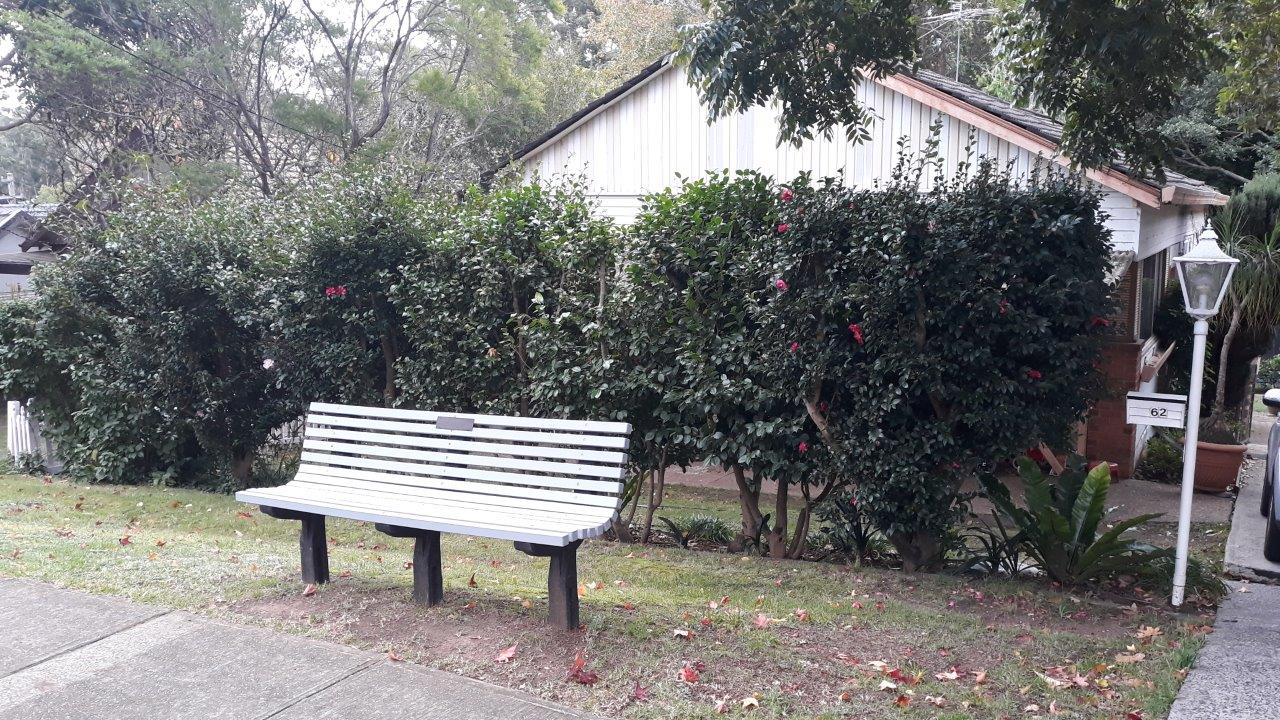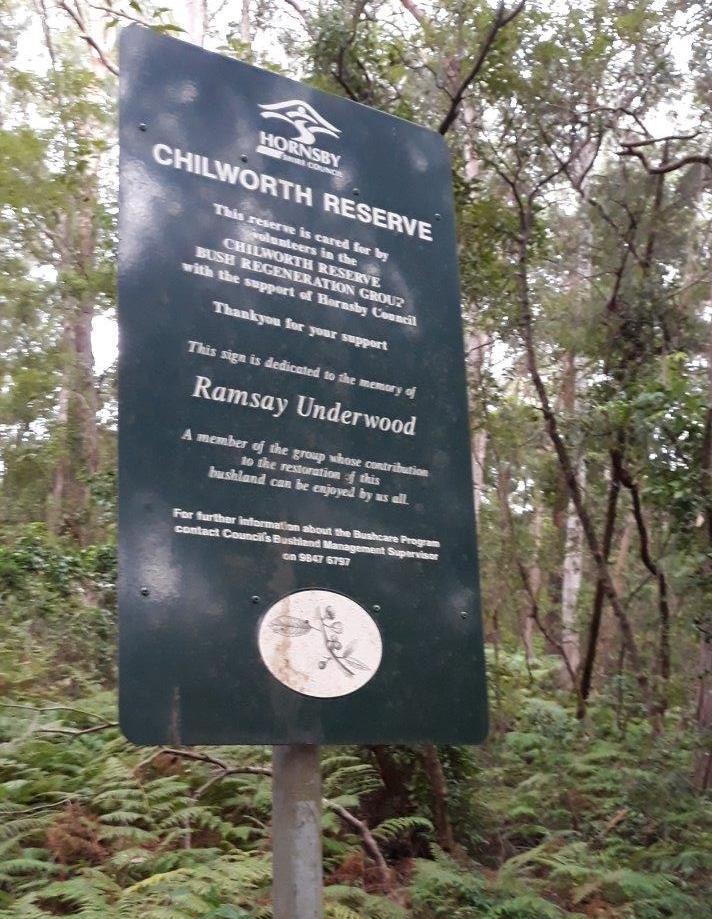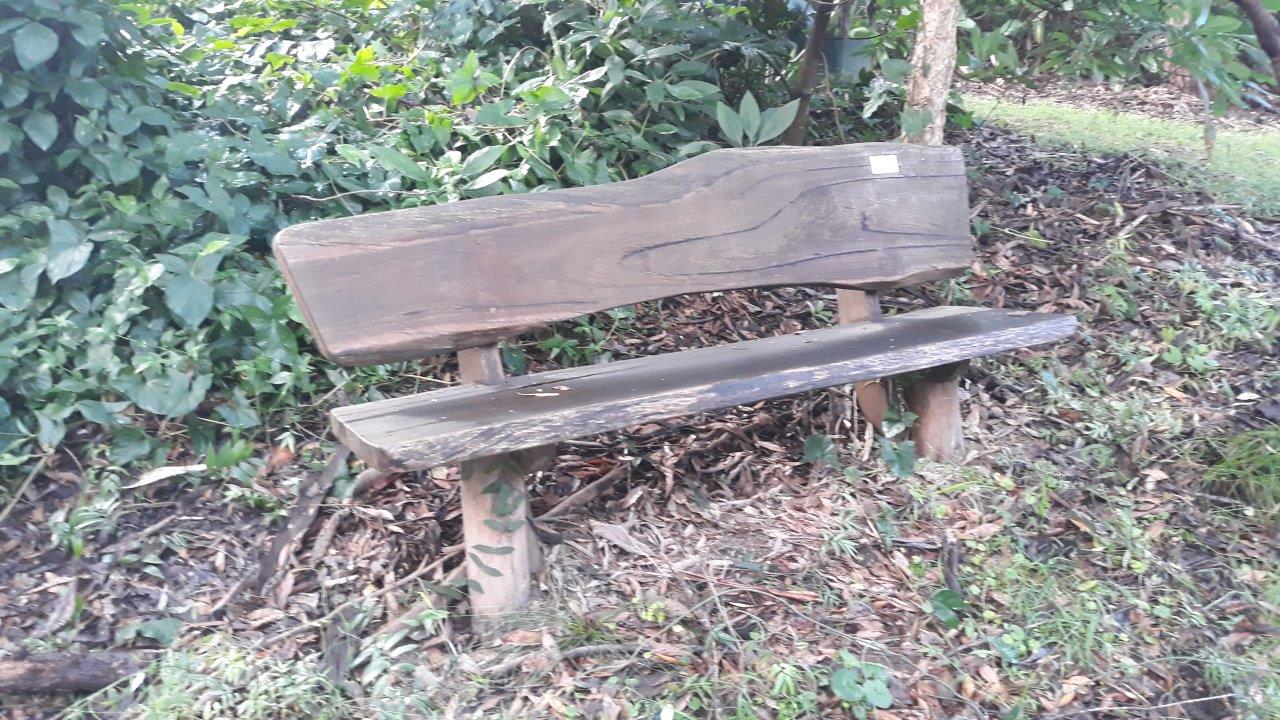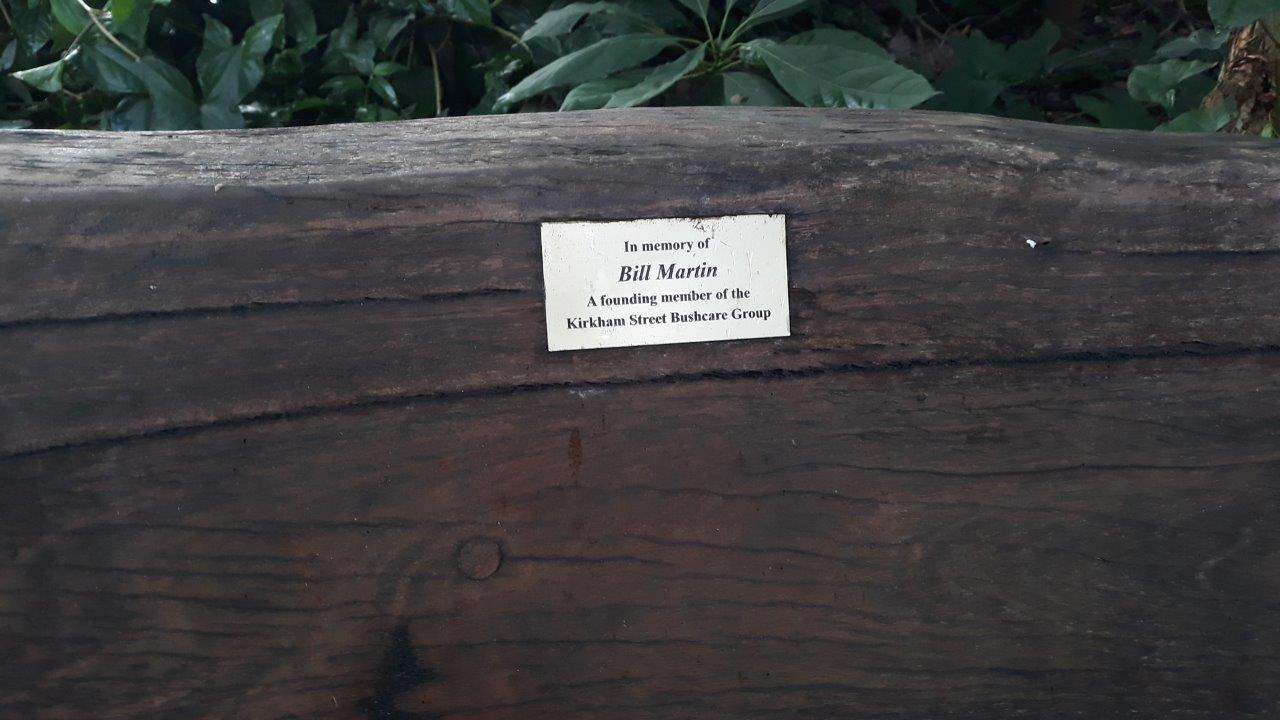The following is information known about memorial seats and signs in Cheltenham and Beecroft that are not buildings (like the Vicars Memorial Hall at Beecroft Presbyterian Church), war memorials (for which see elsewhere on this site) or contained on honour boards or memorials held inside buildings.
For information on monuments generally see: www.monumentaustralia.org.au
Seats for which no information is currently held includes:
· In memory of Miss Camper and located at Beecroft Railway Station
· In memory of Kate Robertson Swan erected by the Red Cross at the School of Arts
· In memory of Charles Robertson Swan and located at The Beecroft Club
· A seat donated by Ida Byles originally in the Beecroft Reserved but moved to the Village Green and inscribed “Rest and be thankful”
1929: Caddy seat – Malton Road
James Caddy was born in Cornwall about 1844. He married Catherine while there. He and his wife migrated to Australia in about 1880. He was a draper and had businesses in Oxford Street Waverley and then Waverley Road Waverley. He was a successful businessman and rose to become General Secretary of the Drapers Association. When he retired in about 1907 he moved with his family to Beecroft. [1]
His children James Pascoe (born 1882) and Winifred (born 1884) were born in Waverley and moved to Beecroft with their parents. His son gained a university degree as a mining engineer and eventually became General Manager of Metal Manufacturing in Port Kembla. James Pascoe served in WWI where he became a Major and was Mentioned in Despatches and awarded the Military Cross. He married Kathleen Giblin of Chatswood in 1921 and they had two boys, John and Peter.[2]
While arriving in Beecroft in 1907 the earliest record for where they lived is in 1915 when James Pascoe enlisted and left from “Trevano” in what is now Arden School in Wongala Crescent. They remain there until the 1927 John Sands Directory shows that they moved to “Korung” Malton Road. They stayed in this home until each died, Catherine on 9 May and James on 24 May in 1929.


[1] The Sun 25 May 1929 p8; Sydney Morning Herald 4 June 1884 p14; Evening News 4 March 1893 and 24 February 1885; Daily Telegraph 21 April 1900.
[2] See the separate entry for J P Caddy under People and WWI; Cumberland Argus and Fruitgrowers Advocate 9 November 1918 p11; Sydney Morning Herald 11 June 1921 and 1 April 1942.
[3] Sydney Morning Herald 10 May 1929 p10, 25 May 1929 pp15 & 16; The Sun 25 May 1929 p8; Cumberland Argus and Fruitgrowers Advocate 30 May 1929; p7; Illawarra Mercury 10 May 1929 p10
[4] An undated clipping of The Epping Times. The original of the subscription booklet and the clipping are now held by the Hornsby Shire Historical Society.
1931: Raoul Robertson Swann seat – Beecroft Road near St John’s Anglican Church
Raoul was born in 1909 in Victoria but the family moved to Sydney in that same year. By 1912 the family lived in a house at what is now the northern end of Wongala Crescent. The family lived at “Kunaware,” Hannah Street Beecroft between 1914 and 1922. Thereafter in ‘Kunaware’ Malton Road – formerly the home of the architect William Nixon. The name ‘Kunaware’ means Swan’s Nest in an Aboriginal language.
He was the son of Charles Robertson Swan (an indentor) and his wife Kate Emma Davidson Robertson Swan (nee Parry). He had one sibling, a sister Una, who became a nurse, married (a solicitor Norman Boyce) and moved to New Zealand. Raoul attended Beecroft College (Miss Long’s School) and then Barker College. In the 1930 Electoral Roll he was described as an architectual draftsman.
When aged 22 years, he went swimming, caught an infection, and died in Royal Prince Alfred Hospital. It is said that the infection led to a tumour that was fatal. [1]
The memorial seat was paid by funds donated by his family to St John’s Anglican Church for the cost of erection and maintenance. The seat was knocked down twice before the present structure was built. [2]
His parents were active in a wide and eclectic range of local and Sydney-wide groups. They were also known for being collectors of books and tea pots, respectively. His father died in 1946 (aged 66 years) and his mother in 1947. [3]
[1] H Barker Houses of Hornsby Shire Volume 11 1880-1938 (Hornsby Shire Historical Society, Hornsby, 1998) p 56
[2] Information supplied by Cath Bartho to BCHG on 22 July 2020
[3] Sydney Morning Herald 10 December 1946 p6, 15 November 1947 p40
1937: C G Milne drinking fountain – Pennant Hills Golf Club
A red brick drinking fountain was unveiled on 29 May 1938 at Pennant Hills Golf Club in memory of its late member C G (Clarrie) Milne. [1] He won the AIF Cup at this club in 1933 [2] and in a cartoon of 1935 he is portrayed as a cigar spoking rotund man and given the title “The Club Humorist” [3].
Captain Milne was a brother of Colonel Milne and the youngest son of Mr L Milne, Deputy Chief Commissioner of NSW Railways and Transport. [4] Captain Milne served during World War 1 in Egypt, Gallipoli, Palestine, France and Belgium. Following the war he was president of the Ryde District Soldiers Club [5] and a member of the Imperial Services Club. He was employed working with the railways. He had not married and lived with his mother. [6]
He died suddenly.
[1] Truth 29 May 1938
[2] Daily Telegraph 28 July 1933 p6
[3] Sydney Mail 5 June 1935
[4] Edmund Milne died aged 58 years in 1917: Goulburn Evening Penny Post 23 August 1917
[5] Cumberland Argus and Fruitgrowers Advocate 10 July 1930 p 11
[6] Truth 5 September 1937
1951: Robert Vicars Gates – The Beecroft Club, Copeland Road
The story of Robert Vicars is elsewhere on this website.
This memorial originally comprised ‘a fine set of iron gates’ but by 2020 consists of gate posts that recognise 24 years of service (22 years consecutively) of Robert Vicars as President of The Beecroft Club – Beecroft Bowling Club. [1] The history of bowling in Beecroft can be found elsewhere on this website.
[1] Sunday Herald 4 February 1951
1960: Gladys Moncrieff seat – Fearnley Park
On 3 December 1960 Gladys Moncrieff [1] unveiled a plaque on a seat built in her honour by local resident J Alan Whatmore. Next to the seat were two plaques of Australia on which were respectively engraved “Gladys Moncrieff OBE ‘Land of Hope and Glory’ ” and on the other “On Wings of Song”.
Mr Whatmore was a brewery foreman and, as part of his admiration for the great Australian singer, presented Miss Moncrieff with two bottles of pilsener on her birthday. Mr Whatmore lived with his wife, 15 year old daughter and 86 year old aunt in Hadley Lodge.
Mr Whatmore said “I never missed one of Glad’s shows and more often than not saw one show about three times. She is a great Australian. She not only has a wonderful voice but a wonderful heart as well – during World War 1 she raised 29,000 pounds in three months for blind soldiers.” [2]

Gladys Moncrieff seat with plaque removed.
[1] Burgis “Gladys Lillian Moncrieff (1892-1976)” Australian Dictionary of Biography Vol 10 p551
[2] Australian Women’s Weekly 23 November 1960 p7, 29 September 1965 p3.
1970s: Bessie Mitchell fountain – Cheltenham Girls High School
A fountain was erected to recognise the services of Miss Bessie Mitchell, the founding headmistress of Cheltenham Girls High School. Information on Miss Mitchell can be found elsewhere on this web site. [1]
[1] L Langtry, In the Pink (Cheltenham Girls High School, Cheltenham, 2017) p80
1980s: Nancy’s seat – 37 Chapman Avenue
This is a tiled seat set into the front fence of the neighbouring house. It was built by the owners of the house in the 1980s – using an old incinerator as the framework.
Nancy was Nancy Smith who commenced living in Copeland Road with her husband in the 1930s. Her husband was Thomas Anthony (Tony) Smith who died in Malaysia on 19 January 1942 resisting the Japanese invasion during WWII. His name is inscribed in on the Beecroft War Memorial. Nancy and Tony had one son, Syd.
Eventually Nancy sold her home and commenced living at Jamieson House on corner of Hannah and York Streets. This was a nursing home and its history is set out elsewhere on this web site. While living there Nancy would frequently walk along Chapman Avenue and sometimes paused to rest outside 37 – where the owners also attended her church, Beecroft Presbyterian.
From this seat Nancy, and others can gaze at the oak tree on the street which was planted around 1935 from one of the seedlings distributed by the department store Anthony Hordern based on its logo of an oak tree at Razor Back Picton and motto “While I live I grow”.
This seat was for Nancy, and others, to rest in their walks. Nancy dedicated the seat and enjoyed an afternoon tea in her honour. Nancy died some years after this event.
A photograph of Mrs Smith is contained in the history of Twilight House [1]
[1] R. Ringer An Australian Story (Twilights Care, Sydney, 2017 )p viii
1999: D C Mitchell seat – 62 Hannah Street


Dorothea Mitchell OAM of 69 Cardinal Avenue was the driving force in the Hornsby Shire Foundation for the Arts, which became the Hornsby Art Society, now located in ‘Wallarobba,’ Hornsby. In her efforts she was supported by Margaret Mary Therese (Tess) Harris of Carmel 115 Beecroft Road [1]. She also assisted with the Northern Districts Education Centre (for which see elsewhere on this web site) and Thornleigh Community Centre. She was made a Member of the British Empire in 1978 and was a Bicentennial medallion in 1988. As noted on the plaque erected by family and friends her support of the arts in the Shire spanned the years 1967-1999.
2001: Ramsay Underwood sign – Chilworth Reserve

A long term resident of 7 Mary Street Beecroft, Ramsay was also a stalwart bushcare worker. He joined the bushcare group in 1995 and commenced work on the eastern side of the creek in Chilworth Reserve, just below Mary Street. By 1998 he had cleared this area of lantana, arundo grass, privet, ochna and weed vines. In 1998 he moved his attention, with that of the group, to work on the southern part of Chilworth Reserve near the scout hall and towards Welham Street.
One Friday morning in October 2000 he said to his wife, Margaret, “Going down the bush” and went down behind 24 Welham Street to remove privet. He had a heart attack and died immediately.
His funeral was at St John’s Anglican Church.
His neighbours Neil and Cathy Tribe on Welham Street paid for the sign in his memory.
It was erected by Council and the bushcare group had input into the wording.
The sign was unveiled in 2001 in the presence of the family, Steven Pringle of Hornsby Council and members of the Civic Trust.
It was Ramsay’s work that was of critical importance to clearing this part of the Reserve. Council has maintained his endeavours.
2017: Donald Bartho seat – Beecroft Reserve

Donald was a bushcare worker and supporter of community activities and organisations for many years. He died after a number of years of illness during which he continued his endeavours to the best of his ability.
The seat was made in 2017 from local timber by Andrew Smith of Timber Creations and was erected by the Council with funding contributed by his widow, Catherine, and his family.

Bill Martin seat – Beecroft Reserve near 24 Kirkham Street

Bill was part of the initial bushcare group that was formed in 2001 to rejuvenate the entrance to Beecroft Reserve. Council erected the seat and his widow Robyn and family contributed the plaque to Bill. The seat was made by Andrew Smith of Timber Creations.
